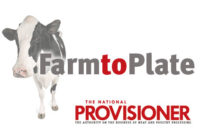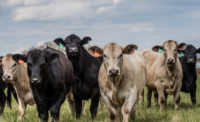I was greeted by a herdsman that was about the same age as my parents. He looked me in the eye and shook my hand in a manner that left me with a great first impression. When I asked if he would be attending the seminar later that day, his no-nonsense response — “Why should I take time out of my day to attend your seminar?” — didn’t surprise me, because I hear similar responses quite often. I didn’t mince words in my reply.
“Because you need to understand what society expects from you and what will happen if you don’t deliver.”
If you’ve been looking for an explanation for the value of animal welfare to the consumer that goes deeper than the impact on product quality and yield, here it is.
The practices that we find acceptable and unacceptable in the world around us are largely influenced by our personal ethics. Personal ethics are our individual feelings of right and wrong, good and bad. They clearly vary from person to person as the issue under consideration changes.
Differences in personal ethic can fuel arguments or drive innovation, depending on the emotional reactions that accompany these differences. The choices that a business owner or manager make are always influenced in part by personal ethics.
When the personal ethics of a majority of a group of people are the same for specific issues, these beliefs become part of the societal ethic. The provision of stunning for commercially slaughtered livestock under the Humane Methods of Slaughter Act of 1978 made the use of pre-slaughter stunning in livestock slaughter facilities part of the societal ethic.
The vast majority of society, which includes everyone from industry personnel to the consumer that has no more connection to meat processing than the meat case at the grocery store, accept it as a standard and necessary part of livestock slaughter.
If we pay attention, it is not difficult to start to flesh out the basics of the societal ethic toward the care of livestock. In April, a gruesome undercover video of unacceptable calf euthanasia methods was recorded at E6 Cattle Company — a large calf ranch that grows dairy calves as replacement animals for dairy farms — by an activist group called Mercy for Animals. The employees in the video used hammers to euthanize calves that were very sick or had little economic value. This was not an acceptable method of euthanasia due to the high risk of not delivering a blow that caused immediate insensibility.
The video is highly inflammatory to those who can bear to watch it. Not surprisingly, the reaction of the people in the livestock industries that I have observed watching the video is largely identical to the reaction of people that do not make their living in agriculture.
This similarity uncovers a piece of the societal ethic toward livestock animals. We find it universally unacceptable to euthanize an animal with a method that has a high risk of inconsistency that can ultimately result in suffering on the part of the animal. This is exactly why society is supportive of adherence to humane slaughter techniques that have been proven effective.
They understand that we raise and slaughter animals for food, but they do not tolerate negligence on the part of those who are responsible for the care, handling and slaughter of livestock.
It is fair to say that society grants the members of livestock agriculture a certain level of trust that the animals under their care will be treated well, handled carefully and slaughtered humanely.
Many call this trust a “social license.” If you do not keep up with the societal ethic, you can expect to lose your social license, which is the privilege to operate your business. In extreme cases, revocation of your social license entails complete closure of your business. More commonly, it results in decreased consumer demand for your products. It is difficult to put an exact monetary value on the impact of a breach of societal trust, but the reaction of consumers to such an event has been identified.
One study1 identified that when an animal-derived food product was offered to a consumer panel with a description of high-perceived standards of facility cleanliness and animal welfare, the consumers were more willing to pay for the product than other products that claimed different combinations of facility hygiene and animal welfare. The researchers also allowed the consumers to taste the products.
They found that consumers relied more heavily on the taste and quality attributes of the product than perceived animal welfare after they tasted the product. This study clearly demonstrates the value of both animal welfare and product quality in consumer decision-making. A high level of perceived animal welfare is helpful in getting a product off the shelf, but the combination of animal welfare and eating quality brings impact whether consumers return to buy the product again or opt for another option.
If a processor intends to add labeling that indicates the animal-welfare standards of their product, there are a few important factors to remember. A study in the U.K.2 revealed several common complaints indicated by adults that were surveyed on animal welfare-related food-purchasing decisions. The top complaint was that an excessive amount of label claims are unacceptable. It appears that too many label claims place the purchaser in a state of “information overload.”
Consumers in the study also were confused about many label claims regarding animal welfare because they did not understand the production practices. Finally, and importantly, many consumers believed label information regarding animal welfare was biased, and they were unsure which companies were actually telling the truth!
The importance of animal welfare to the marketing of meat, milk and eggs has been described in research and identified by many niche marketers in recent years. Information regarding good animal-welfare practices helps consumers to choose one product over another.
However, before we flood the shelves with animal-welfare labeling, it is important to remember a few things. The consumer has to understand what the label claim means, you have to consistently source product or raise animals in facilities or using practices that adhere to your label claim, and most importantly, you have to make a great tasting product that the consumer will purchase again and again.
Consumers remain skeptical and uninformed regarding animal-welfare product claims, and processors need to respond with education and simplicity.
Kurt D. Vogel is an assistant professor of Animal Science with an emphasis in livestock behavior and welfare at the University of
Wisconsin - River Falls. For more information, contact him at kurt.vogel@uwrf.edu or (715) 425-3704.
ENDNOTES
1) Carlucci, A., E. Monteleone, A. Braghieri, and F. Napolitano. 2009. Mapping the effect of information about animal welfare on consumer liking and willingness to pay for yogurt. J. Sensory Studies. 24:712-730.
2) Schroder, M. J. A. and M. G. McEachern. 2004. Consumer value conflicts surrounding ethical food purchase decisions: a focus on animal welfare. Int. J. Consum. Stud. 28:168-177.





